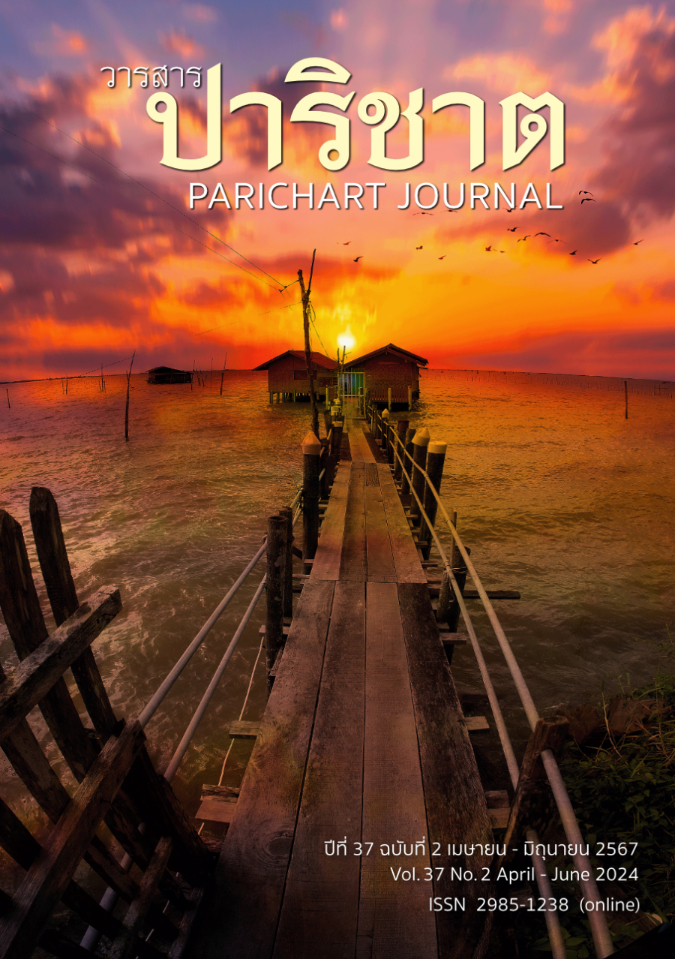The Backchannel Functions in Conversations among Korean Learners of Thai as a Foreign Language
Main Article Content
Abstract
This research article aimed to analyze the functions of backchannels used by Korean learners of Thai. The objective was to address questions regarding the function of backchannels in Thai conversations and whether these backchannels facilitate communication in the target language. The study, conducted by collecting data from conversations in the “Cullen HateBerry” channel, analyzed and presented the data according to qualitative research methods. The result of the study revealed that Korean learners used backchannels in two ways: through reconstruction and based on the target language. The reconstructed backchannels encompassed both non-lexical and lexical forms, conveying agreement, expressions of gratitude, emphasis, insistence, and queries. The study suggests that non-lexical backchannels tend to be inconsistent with the target language because they operate at a pragmatic functional level, which is a culture-specific code and cannot convey the semantic meaning. In contrast to lexical backchannels, which convey content meaning, non-lexical forms exhibit semantic meaning clearly. Consequently, non-lexical backchannels, when transferred from the mother tongue, tend to be less consistent with the pragmatic understanding of the target language.
Article Details

This work is licensed under a Creative Commons Attribution-NonCommercial-NoDerivatives 4.0 International License.
References
Young, R. F., & Lee J. (2004). Identifying units in interaction: Reactive tokens in Korean and English conversations. Journal of Sociolinguistics, 8(3), 380–407.
Nurjaleka, L. (2023). Backchannels responses as conversational strategies in the interaction of Indonesian speakers in interview setting. Journal of Research and Innovation in Language, 5(2), 99-114.
Sbranna, S., Wehrle, S., & Grice, M. (2023). The use of backchannels and other very short utterances by Italian learners of German. [Peper Presentation]. The position of the speaker in interaction: Attitudes, intentions, and emotions in verbal communication. Italy.
Hasanam, N. (2016). Backchannels adopted by equal status in Thai conversation [Master’s Thesis, Chulalongkorn University].
Hasanam, N., & Panpothong, N. (2022). Backchannels in Thai and the effects of status: A case study of conversation between teachers and students from the Mister O corpus. Manutsayasat Wichakan, 29(1), 189-217.
Intachakra, S. (2007). Fundamental concepts of pragmatics. Thammasat University Press.
Hyun, Y. (2016). An interlanguage pragmatic study on the disagreement strategies of Korean students who speak Thai as a second language in Thai argumentative conversation. Journal of language and Linguistics, 34(2), 1–19.
Ngoenthum, N. (2014). An error analysis of Thai sentences made by Korean learners [Master’s Thesis, Srinakharinwirot University].
Chitprasong, C., & Klinnamhom, R. (2021). Thai Language Usage Errors of Korean Masters of Ceremonies in Travel Documentary Television Shows. Academic Journal of Humanities and Social Sciences Burapha University, 29(2), 24-48.
Sangsoda, E. (2023). Thai food presentation on Korean guide channel: Pragmatic transfer of Korean presenter who uses Thai as second language. [Paper Presentation]. Commemorative International Conference for the 65Th Anniversary of the Diplomatic Relations Between Korea and Thailand. Korea.
Kanchina, Y. (2023). An analysis and comparison of the request strategies used by native speakers of Thai and Korean speakers of Thai. Journal of Studies in the Field of Humanities, 30(1), 141-169.
HateBerry, C. (2023). Cullen HateBerry playlists. [Video]. YouTube. https://www.youtube.com/@cullen_hateberry/playlists
Yngve, V. (1970). On getting a word in edgewise. [Paper Presentation]. Papers from the sixth regional meeting of the Chicago Linguistic Society. Chicago.
Ike, S. (2010). Backchannel: A feature of Japanese English. [Paper Presentation]. JALT 2009 Conference Proceedings. Japan.
Yule, G. (1998). Pragmatics. Oxford University Press.
May, J. L. (2000). Historical dialogue analysis. Pragmatics and beyond new series. Journal of Pragmatics, 32(10), 1539-1550.
Wales, K. (2001). A Dictionary of Stylistics (2nd ed.). Pearson Education Limited.
Duncan, S. J. R. (1974). On the structure of speaker-auditor interaction during speaking turns. Language in Society, 3(2), 161-180.
Li, H. Z. (2006). Backchannel responses as misleading feedback in intercultural discourse. Intercultural communication research, 35(2), 99-116.
Lee, K. (2020). Backchannels as a cooperative strategy in ELF communications. Korean Journal of English Language and Linguistics, 20, 257-281.
Beltrán-Palanques, V. (2023). Exploring learners’ backchannel production in complaint sequences across proficiency levels. International Journal of Instruction, 16(2), 1-14.
Kraaz, M., & Bernaisch, T. (2020). Backchannels and the pragmatics of South Asian Englishes.World Englishes, 41(2), pp. 224-243.
AYTAÇ-DEMIRÇIVI, K. (2021). Backchannels in spoken Turkish [Doctoral Dissertation, Middle East Technical University].
Wutthichamnong, W. (2015). Other-repetition in Thai conversation [Master’s Thesis, Chulalongkorn University].
Ochaphan, S. (2022). Simultaneous speech in Thai conversation: A case study of Hone Krasae Telavision Program. Journal Thai language and literature, 39(1), 92-137.
Cutrone, P. (2014). A cross-cultural examination of the backchannel behavior of Japanese and Americans: Considerations for Japanese EFL learners. Intercultural Pragmatics, 11(1), 83-120.
Engwall, O., Cumbal, R., & Majlesi, A. R. (2023). Socio-cultural perception of robot backchannels. Frontiers in Robotics and AI, 10, 1-19.
Yamashita, Y. (2017). Response behaviors in conversational speech among Japanese- and English-speaking parents and their toddlers. [Paper Presentation]. Advances in speech-language pathology. Brazil.
Ueno, J. (2008). Gender differences in Japanese conversation. Union College.
Bodur, K., Nikolaus, M., Prévot, L., & Fourtassi, A. (2022). Backchannel behavior in child-caregiver video call. Cognitive Science Society, 44, 3072-3079.
Wannaruk, A. (2008). Pragmatic transfer in Thai EFL refusals. Regional Language Centre Journal, 39(3), 318-337.
Kraft, B., & Geluykens, R. (2007). Defining cross-cultural and interlanguage pragmatics. LINCOM GmbH.
Gass, S. M., & Selinker, L. (2008). Second language acquisition: An introductory course (3rd ed.). Routledge.


